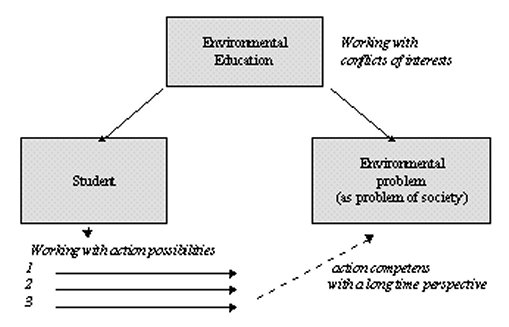Action competence – The challenge for future environmental educationToday the prospects and therefore the challenges are different. The following extract from an interview with a well developed 16 year old, made by the author of this booklet when doing research on MUVIN, gives an indication of the problem. The background for the quotation was a question on how far the student was worried about his future because of environmental problems.
”I damn well doubt whether they’ll let me live my life without ….the world is being smashed completely….it’s getting worse and worse….why the hell doesn’t anybody do something …it worries me a lot .. when you come to think about it you get bloody well depressed for a while”
Even though this student’s worries are probably not characteristic of Danish students generally, his statement is not uncommon. There well may be similar conceptions among the students who cannot be bothered with environmental education.
Whether this is the case or not the quotation cited nevertheless gives occasion to consider and decide how the aims, planning and evaluation of environmental education can be described so that this type of student can benefit from the teaching.
The wish to reverse the students’ worries about the future, their despondency, and apathy and replace it with a belief in their having the chance to leave their mark on development in the environmental field and act in accordance with their belief, has often been mentioned as the wish to develop their action competence.
To develop action competence in the environmental field consists of developing the students’ general abilities and the will to get involved, of making a stand and of acting, and not of the teacher prescribing on their behalf what they ought to believe and do in concrete environmental questions. This is how the concept of action competence supports the democratic aspect in Danish educational thinking, which does not regard the students as empty jars which are to be filled with the correct knowledge, attitudes and actions, but on the contrary, emphasises that they are equal as human beings who are to be qualified so as to be able to manage the conditions for their lives.
It is also imperative that a certain sensitivity is demanded so that students do not feel choked by it, but rather develop a keenness and will to get involved and do something about environmental problems which they will be confronted with as adults.
Environmental problems are first and foremost problems of society
That environmental problems should be regarded first and foremost as problems of society is another condition that makes it necessary for planning, implementation and evaluation of a course to be brought into different ways of thinking than former practices.
Previously, environmental problems were mainly regarded as being connected with effects on nature. Consequently teaching was concentrated on investigating the effects on nature, and typically, the environmental problem was seen as a problem between society and nature. For instance, subsoil drinking water was in a critical state, and that was the farmer’s fault because he fertilised his fields with artificial manure!
When environmental problems are first and foremost regarded as problems of society the emphasis is placed elsewhere. Subsoil water reservoirs are not in a critical state, it is our opinion and belief in how pure subsoil water ought to be that contrasts with the production practices in the interests of the farmer. The societal point of view is futher underlinned by the point that the farmer actually fertilises his fields in order to grow products, which are cheap for the consumer.
The view of ”the old form” of environmental education and the form that is being supported in this booklet can be illustrated as follows:
Behavioural shaping

Development of action competence

Fundamentals of present day environmental education
The essence of the aspects of present day environmental education as described above can be stated in the following essentials (Breiting and Janniche, 1995) which were also the basic ideas for more than 100 development programmes within the MUVIN and Green City projects.
The points can be used to advantage by teachers as a basis for their discussions on the future planning and implementation of a course in environmental education.
- environmental problems regarded as problems of society
- environmental education regarded as interdisciplinary and problem orientated, and much emphasis is laid on student participation in decision making and responsibility
- emphasis is placed on working with the conflicts of interest in the exploitation of nature, as well as the students having the opportunity to assess and take a standpoint on the ethical aspects of the problems
- emphasis is placed on the students getting out of school and investigating the problem being worked on, part of which consists of getting into touch with people with different opinions on the particular problem
Go to next chapter
- it may prove productive for the students to gain experience in testing some action possibilities related to the environmental problem they are working on.
This is chapter 1 of 5 chapters of:Environmental Education - development and evaluation
by
Finn Mogensen, Ph.D
Research Centre for Environmental and Health Education
The Royal Danish School of Educational Studies
fm@esbjerg.dlh.dk